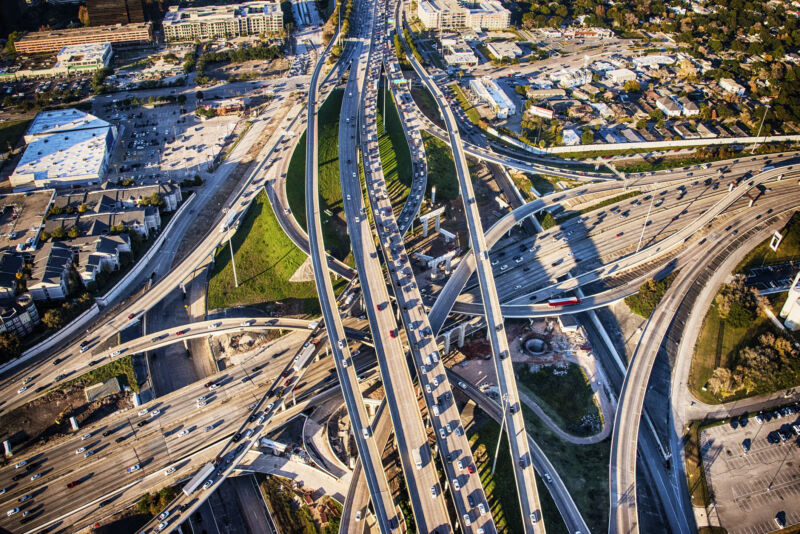🛣🛣🛣🛣🛣🛣🛣🛣🛣🛣🛣🛣🛣🛣🛣 —
Why do highway planners refuse to accept that more lanes means more traffic?
Jonathan M. Gitlin
–

Enlarge / The intersection of Interstates 10 and 610 in Houston, Texas, during evening rush hour.
Getty Images
You often hear people say that the definition of insanity is doing the same thing over and over again and expecting different results. I bring this up because of an interesting—if infuriating—thread I read this morning about Texas’ plan to widen I-35 as it cuts through the heart of Austin.
Unsurprisingly, the state wants to build more lanes, which it thinks will ease congestion. At some points, this could leave I-35 as much as 20 lanes wide; this will require bulldozing dozens of businesses along the way. An alternative that would have buried 12 lanes of the highway in two levels of underground tunnels was apparently considered too costly.
But it would be wrong to single out this 8-mile proposal as an outlier. In Houston, the state plans to widen I-45 despite plenty of opposition, including from the Federal Highway Administration. And you don’t have to look far to see other state governments wanting to build new roads to reduce congestion.
Maryland Governor Larry Hogan wants to add four more lanes to I-270 and I-495 to funnel commuters into the District of Columbia and its surrounding office parks more quickly. In the Chicago suburbs, an eight-year project to add more lanes to a 22-mile stretch of I-294 began in 2018. And Atlanta might soon be entirely paved over, such is the rate that Georgia plans to add new highway lanes. And these are just three examples of state governments blindly following the trend.
The infuriating bit is that the evidence is pretty clear: these are deeply misguided policies. While it seems intuitive that the solution to three lanes of gridlock is to spread the same number of cars over four lanes, it fails because of a phenomenon called induced demand.
Reducing traffic might make sense if the only variable were the number of road lanes. But it isn’t—as Ray Kinsella was told in Field of Dreams, “If you build it, they will come.” Except this time, “they” refers to more cars. When people know a particular route is congested, some of them will choose not to drive. But once you tell everyone that you’ve added more lanes to that road, that latent demand has an outlet—at which point the traffic jams return, but now with even more cars in them.
Induced demand is not a particularly novel idea; Robert Caro’s The Powerbroker describes exactly this problem showing up in New York following Robert Moses’ bridge-building in the 1930s; back then it was called “traffic generation.” Researchers started collecting hard data on the problem toward the end of the 20th century, and in the past few years more and more studies have confirmed the fact that when you build more lanes on already-congested roads, traffic simply grows to fill those new lanes as well.
The root of the problem probably lies in another frequently misattributed quote—it is indeed difficult to get someone to understand something if their salary depends upon them not understanding it. It just seems a little unfair to the rest of us that the consequence is more cities being choked with traffic.

